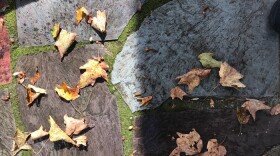Officials in the Northeast are asking for the public’s help in combatting the Spotted Lanternfly.
Chris Logue, The New York State Department of Agriculture and Markets Director for Plant Industry, says although the inch-long insect with black-spotted gray wings and red underwings will perish in the first frost, they’re busy now laying eggs to continue a new generation come spring.
"We have had several sightings in upstate New York, in particular we've been concerned with, with Ithaca, where we did have a report last year, and where we did take some action to reduce egg mass numbers, over the winter months. We've had observations of small numbers of adults when our survey crews have been back in the in the Ithaca area. And we do have some plans for a treatment in the works there."
Native to China and Vietnam, the Spotted Lanternfly was first discovered in Pennsylvania in 2014 and now has a foothold in several Northeastern states. It feeds on over 70 plant species including grapes, hops and apples.
Brian Eshenaur with New York State Integrated Pest Management says although they can feed on sugar maples, it’s not their favorite, they don’t stay there too long. So it appears there will not be a negative impact on sugar maple trees or syrup production.
"It does happen. But fortunately it's rare to see diebacks on maple tress they're accumulating on, so they are a nuisance but they don't threaten the tree itself." Eshenaur adds the insects could have a significant impact on New York's wine and grape industry.
He points out that on their own the bugs can move up to four miles a year, but most movement is attributed to their "hitchhiking" skills — adults will lay egg masses on just about any surface, and seem to like rusty metal. Often the bugs are spread by traveling vehicles or in shipments of produce, wood, or landscaping materials.
The insects have also now appeared in Fitchburg, Massachusetts. The state's Department of Agricultural Resources announced an infestation of what they're calling a "breeding population" found in a cluster of trees.
Officials in Connecticut say the degree of impact of the insect on urban and rural forest trees there is uncertain, and may turn out to be more of an annoyance with minor impact on forest health. However, there is the potential that it could cause much more significant damage.
The Vermont Agency of Agriculture says three of the bugs were found in Rutland in a shipment from a state with known infestations. Although the situation is considered resolved, officials say any further sightings should be reported.
In New York, Logue says there have been confirmed sightings of the bug in the counties of Albany, Westchester, Otsego and Delaware, but no evidence of infestation.
"If someone from the general public finds one, if they can take a photo of it and report it through the reporting tool, that's very, very helpful. And it's also very helpful if they can safely collect a sample of the spotted lanternfly, and they can put it in hand sanitizer or put it in the freezer to kill it and then report it to us. We're prioritizing responding to reports right now out of out of the upstate area, and really want to be continued to be very vigilant with those."
Do you think you found a Spotted Lanternfly? In New York, report it to NYS Dept. Agriculture and Markets, using the Spotted Lanternfly Public Report.
Vermonters can report any possible sightings of the bug through this state website.
In the Nutmeg State, follow the instructions on the Connecticut Agricultural Experiment Station Spotted Lanternfly sample submission form to send a dead specimen sample; or take lots of photos and carefully note the location to report your finding to the Connecticut Agricultural Experiment Station (CAES) at ReportSLF@ct.gov.
If spotted, Massachusetts residents are asked to photograph, collect and report the insects to the state.







